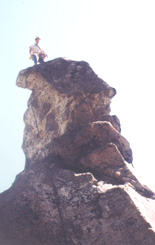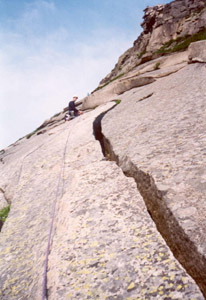The Eaglet

The Eaglet (5.6)
The Eaglet is a solitary pillar standing out from the cliffs across from Cannon Mountain. The hike out is about 45 minutes up hill.
Park in the Tramway parking lot at Cannon Mountain and walk back under the highway. To the left is the beginning of Greenleaf Trail. Hike up Greenleaf Trail until you get to a large cairn on the left. There is also a bike reflector nailed to a tree at this point. Turn off to the right at this point and continue up for about 1/2 of an hour. If you miss this turn, there is another cairn on the left a litter further up. You can turn off here as well.
Once you get to the base of the Eaglet, you need to hike up and to the right along the scree. We climbed up a notch where there was a set of slings part way up. At the top of the pitch you can walk over to the Eaglet to begin the next pitch. The beginning of the short pitch up the Eaglet is a 5.6 with a bolt before the tricky move. Once you are past the crux, the climbing is short and simple to the (almost) top.
The climb ends at a fixed anchor for rappel behind the top of the climb. You have to step above the anchor to a sloped surface to stand on the top. It is kind of scary, but it makes a neat picture to show your mom.
The first rappel is from the rappel anchor near the top of the climb to where you started the second pitch. We walked back to the first pitch and down climbed a few moves (on belay) to the anchor where we belayed from. Because there were no other parties out there that day, rappelling the route was our best option.
It is a bit windy and the sun can be harsh. I wished I had brought up my wind breaker and sunscreen and recommend that anyone else bring these two items along with lunch and water - it is a nice place to sit for a while!
While we were there, a peregrine falcon flew over us and landed on the cliffs in front of us. He watched us climb for the remainder of the afternoon. This climbing area is closed for a large part of the season because of peregrine falcon nesting. (They do not build nests, they lay their eggs on large ledges.) It is important to make sure that the nesting season is over and that the young have taken flight before you climb in this area. September is a very nice time to do this climb.
Cannon

Cannon cliff is the site of some of the most spectacular and varied climbing in the region, and also some of the most committing. The climbs include short climbs, multi-pitch climbs, and big wall free and aid routes, with ratings from 5.5 up to 5.11. Many classics abound, from the moderates such as Lakeview, Whitney-Gilman, and Moby Grape to the demanding VMC Direct, the first grade V big wall on the East Coast.
The climbs on Cannon are typically of a more serious nature than those found on Whitehorse or Cathedral. There are a number of logistical aspects that need to be taken into account, including loose rock, weather, and route finding. While these factors should always be considered, on Cannon they may become imperative.
The cliff face is composed of blocky, often exfoliated granite (the extensive talus field below attests to this), requiring climbers to be constantly on alert for shifting and fractured rock. Once while on the historical Whitney-Gilman ridge, my partner and I were required to wait on a ledge with another party of two while a pair of climbers above us, who had decided to rappel the route (?), descended past. They managed to dislodge a basketball sized block with their ropes, which headed straight for us. It ended up breaking in two, with one piece scoring a direct hit on part of our anchor and the other piece coming so close as to actually glance off the hands of one of us. (Another party of two who were a pitch or two below us bailed off after this episode.)
Although Cannon seems to have been relatively quiet in terms of rock fall in the recent past, it seems to have increased somewhat in the last year or two and several large rock falls have been observed. Accordingly, some of the climbs have undergone some changes.
At a local rock gym I was told a story about climbers on Cannon who discovered near the end of a route that rock fall had all but obliterated the belay stance.
Unable to down climb, the leader set up the best belay he could given the circumstances, which included backing up the pieces with a nut tool hammered into a crack with a loose rock!
Those unfamiliar with the routes may be able to obtain some information regarding particular climbs by contacting IME or Ragged Mountain (many climbers are on their staff and may be able to give relevant information) or by talking to the locals.
The weather is also a factor. Cannon faces east; bad weather often approaches from the west. Carry rain gear and be prepared to rappel off in the face of inclement weather. The notches in NH often have their own weather: Franconia notch may be socked in by rain, whereas neighboring Crawford Notch may be sunny.
Rock fall is a part of climbing at Cannon (have we mentioned this already?). We wear helmets and use double ropes. I know someone whose rope was cut on Whitney-Gilman. I also know someone who was hit on the head with a rock on Cannon and her helmet broke. It protected her head.
Lakeview (5.5)
This climb ascends underneath and up along the side of what was once New Hampshire's most prominent landmark, the Old Man of the Mountain. The climb really is spectacular, and was once listed as a classic in Rock & Ice. Although there is some loose rock (especially on pitches 5 & 6, which are essentially grade 4 pitches), most of it is solid and the protection is pretty good. A large cam such as a Camelot #4 would make pitch 2 better protected, although it is not necessary. There is, however, a somewhat exciting run out on pitch 3.
The climb is graded at 5.5, but there are variations that will make it higher if such was desired. As a forewarning, there is a vertical crack on the last pitch of the defined route that may seem harder than a 5.5. There are also climbs up to 5.11 that branch off of Lakeview.
Whitney-Gilman Ridge (5.7)


This is a classic ridge climb of some historical importance. It saw its first ascent in 1929 (done without pitons), at which time it was considered to be one of the hardest climbs in the United States. There are now several pitons and bolts, but a standard rack is still necessary.
There are several variations to the climb, but most generally stay in the 5.7 . 5.9 range. The original 5.4 start is somewhat loose and dirty. I personally like the 5.5 start of the 5.8 variation, which Webster calls .Variation #1.. The climb can still be done at 5.7 even with this start, as one can easily connect up with the original line before the 5.8 section is encountered.
The most celebrated pitch of this climb is the so-called Pipe Pitch. (pitch #3 of the original line).
On the pipe pitch, the climber moves up and around a very exposed corner on the edge of the arete, and is subjected to a view into the dark abyss of the immense and rotten gully on the north side of the Whitney-Gilman Ridge called the Black Dike.
Please note that even though the pitch starts at a knee sized crack, it is not a good move to actually place your knee in the crack. (You would not be the first to be rescued from this place because your knee got stuck.)
Several climbs start near the Whitney-Gilman Ridge and connect with it midway up the ridge; these are in the 5.7 . 5.11 range. I don't personally know anyone who has climbed them, though I've seen people on them. Webster's descriptions indicate that loose rock is present on some of them.
When you have completed Whitney-Gilman, you can hike down the south side of the mountain by way of a trail. This is the same trail used in the winter as the decent for the Black Dike. The trail is steep and eventually winds around to the parking lot.
Please remember to sign out at the climber's registry box before you leave. Someone really does come around to check it - we ran into him at the end of a very long day!
Moby Grape (5.8)

If you go to climb Moby Grape, skip the first pitch and climb Reppy's Crack up to the rappel slings as an alternate first pitch. The crack is a great hand/foot jamb for most of the pitch. It is best to wear shoes that cover your ankles or to tape or somehow cover your ankles for this pitch. I still have a nasty scar from my foot sliding about 6 inches down the crack. Of course all I had to put on it at the time was spit which may have a lot to do with it.
There are several other memorable pitches. The next one is a roof with a crack that you can layback and then reach over and around to get another hand jam to get over the roof. Because you can place protection on the edge of the roof in the crack, a fall for the leader can be relatively safe if the belay is good.
The other memorable pitch is the "Finger of Fate". This is a flake that sticks out enough for you to squash you and your pack into the chimney so you can squirm up. It is also possible to try to climb the face on the outside, which is what I finally did after giving up on the slithering moves.
When you complete the climb you are not at the top of the cliff. You can walk off or continue to climb up easy pitches to the top and hike down the path from there.
Recommended Books
Rock Climbs in the White Mountains of New Hampshire, 2nd edition, Ed Webster (Mountain Imagery)
The published guide we used for this cliff is Ed Webster's Second Edition of Rock Climbing in New Hampshire's White Mountains. Our copy is, unfortunately, a little outdated due to the rock fall of the Old Man of the Mountain, but is still indispensable.
Emergency Checklist
Climbing on Cannon is serious. The approach is difficult, there is a lot of rock fall, and many of the routes and descents take a long time. There are many parties out there and your ascent can be slowed by others. It is important that you have everything you will need in an emergency, for example a change of weather. The storms often come from behind the cliff so you don't know it is coming until it is there. Basically, (disclaimer), you will die.
- Helmet
- Rain Gear
- Rappel stuff - be ready to bail if you have to. We bring rappel rings and extra slings
- Head lamp
- First Aid kit
- Fleece jacket or insulation layer - it can get very cold in the summer, too
- As the routes are long, many climbers take a photocopy of the route description and topo with them, either laminated or placed in a zip lock baggy
Please note this is for reference only based off our visit to the cliff. Do not email requesting instruction.





